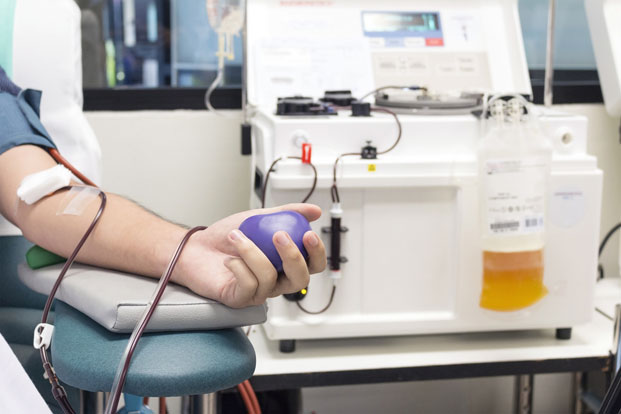Do you want to give the gift of life?
When it comes to donating blood, we often think of donation at routine work or school blood drives as the only method of giving the “gift of life” through blood. This is a life-saving measure that is undisputedly needed on a regular basis.
However, there’s another type of blood donation that’s just as important. That donation is the gift of plasma. Unfortunately, this type of blood donation is much less common.
Consider these important statistics. Each year it takes 1,200 plasma donations to treat one hemophiliac. It takes more than 130 individual plasma donations to treat one patient with a primary immune deficiency.
These are just two of the reasons that healthcare professionals stress the importance of plasma as a key blood component of modern medicine. When it comes to saving lives, plasma is crucial.
According to DonatingPlasma.org, plasma is what remains after blood is stripped of red and white blood cells, platelets and other portions of the blood. It’s a clear or straw-colored liquid as opposed to the red color that we picture “whole blood” to be. It’s also obtained in a different way than whole blood.
Plasma isn’t just a small part of blood. In fact, experts say that it comprises 55 percent of our blood. Plasma itself contains mostly water and includes salts, enzymes, antibodies and various proteins.
The truth is that plasma donors fall into an elite category of cherished donors. That’s because most people don’t donate this needed element of blood. Instead, they donate whole blood during routine blood donations. Though this type of blood donation is always needed, plasma is, too.
Plasma has many purposes. For starters, those with leukemia need it, as do those who have received organ transplants to help keep the body from rejecting the transplant. It’s even helps in treating burn patients.
Plasma donation must be scheduled. Plasmapheresis only takes place at certain American Red Cross Donation Centers, which is why it’s important to call to find out where plasma can be donated.
In some places, plasma donations are compensated. In fact, the paying plasma market has grown by leaps and bounds, spawning wide debates about the ethics of this process. This is because the general process of plasma for pay has created an industry that many question.
So just how big has this industry gotten? According to information published in The Atlantic, “plassing” grew from a $4 billion industry in 2008 to a more than $11 billion industry at the time of the article’s publication in 2014. That’s a huge leap.
The choice as to which route you choose in the way of plasma donation is up to you. However, if you do plan to donate plasma, you need to know that plasma donation is different than routine blood donation in that it requires a special machine. This is why appointments should be made ahead of time.
According to the Red Cross, this machine separates the plasma, red cells and platelets. It then returns the red cells and/or platelets back to the donor with the addition of saline solution. The actual donation process is said to take about an hour and 15 minutes.
The donor’s blood type is important. In the plasma world, Type AB donors are considered gold. That’s because they are what are known as universal plasma donors — anyone can receive their plasma. (Only 4 percent of the population is said to have Type AB blood, so it’s rather rare. But anyone can donate.)
Further, there’s a general process that donors go through when blood is donated. According to the Red Cross, blood donors must be in good health and at least 17. However, 16-year-olds can donate blood with the permission of their parents in some states. In addition, donors must weigh at least 110 pounds.
Blood donors undergo a quick physical exam. In this process, temperature and blood pressure is taken and the pulse and hemoglobin will be measured. Prepare for a donation by consuming ample fluids before donation and eat a healthy, iron-rich meal.
You’ll also need to bring a list of any medications that you take as well as an ID. A driver’s license or two other forms of ID are acceptable. You will be asked about health history, and blood is tested for various diseases, like HIV, hepatitis and West Nile virus.

Leave a Reply